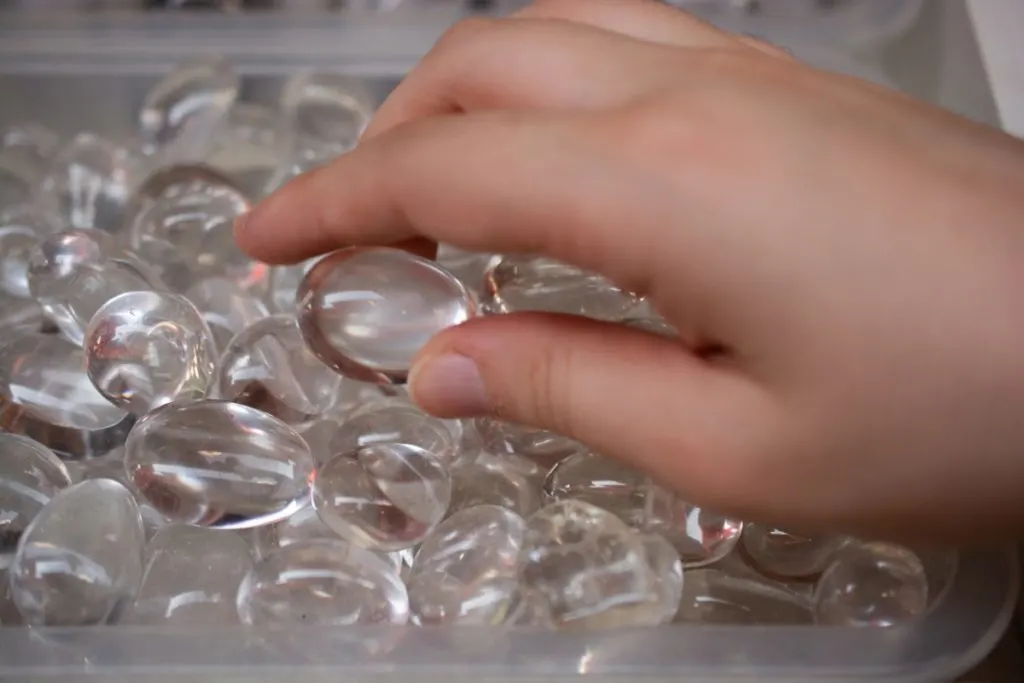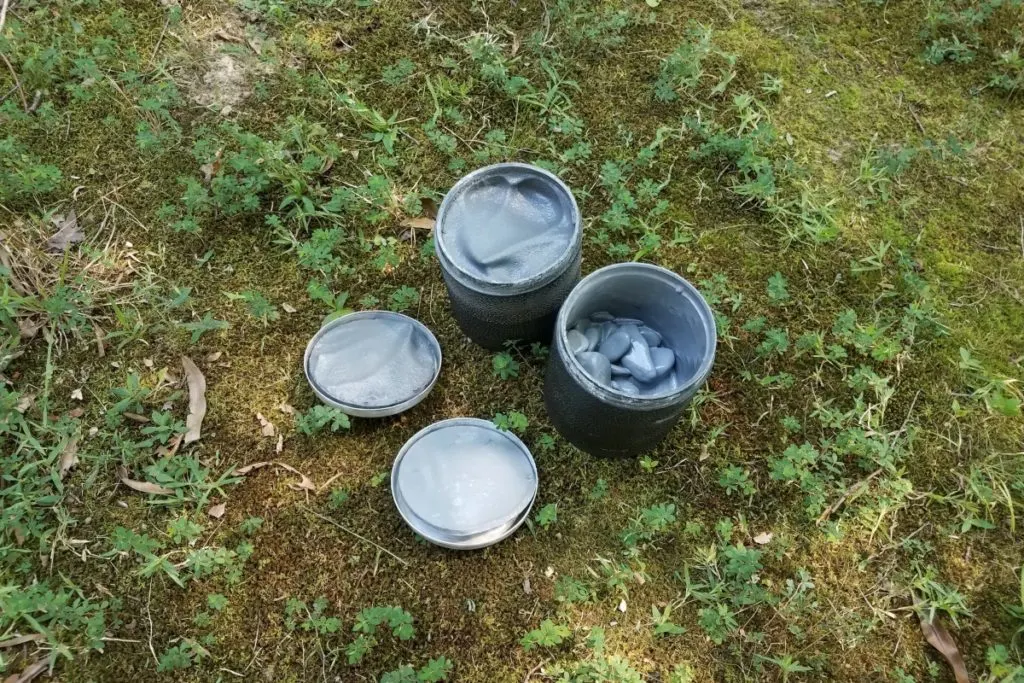Tumbling gemstones is not quite as straightforward as filling the tumbler and switching it on. There are some key supplies and equipment you need to ensure your tumbled rocks come out looking smooth and shiny.
Various grades of rock tumbling grit, polish, and ceramic or plastic tumbling media are the basic supplies you need, in addition to a rock tumbler. Without these accessories, your rocks may come out of the tumbler looking, cracked, chipped, or dull.
This article will guide you through the basic things you need when starting out in the hobby of lapidary. Having all the right equipment and supplies will guarantee good results and make the tumbling process go faster.
If you are interested in checking out the best tumbling grits you can find them by clicking here (Amazon link).

What Supplies and Accessories Do I Need for Rock Tumbling?
The most important supplies you need to get before you begin tumbling rocks are:
- Silicon carbide grit in coarse, medium, and fine grades
- Polishing grit
- Ceramic or plastic tumbling media
Rock Tumbling Grit
Rock tumbling accelerates the natural process whereby a river polishes stone. Rock tumbling grit is what we use in a rock tumbler to replicate the natural abrasion that river rocks are exposed to.
The grit mixes with water as the tumbler barrel rotates, coating the rocks. As the rocks are tumbled, they rub against each other, the grit acting like sandpaper to smooth sharp edges.
Rock tumbling grit is made from synthetic silicon carbide. It is a hard material that is crushed into sharp particles of various grit sizes
On Mohs hardness scale, silicon carbide is over 9, making it much harder than most rocks we tumble (jasper, agate, and petrified wood are only a 7 on the scale).
Its hardness and angularity are what gives it the ability to grind and shape rocks. Silicon carbide grit is also inexpensive, making it great for a hobby lapidarist.
Beginners often try using beach sand instead of grit to save money, but there are a few drawbacks:
- Beach sand particles are rounded instead of angular.
- Sand is softer than grit, so it is less abrasive.
- You have to run the rock tumbler for longer, using more electricity.
Grits for Rotary Rock Tumblers
In a rotary tumbler, one uses three different grades of silicon carbide grit.
- Start with coarse 60/90 grit – this grinds the rough shape of the rock, smoothing sharp edges.
- Move onto medium 150/220 grit – this grinds away the scratches on the rock’s surface from step 1.
- Fine 500 grit – this smooths the rock even further, getting it ready for the final step of polishing.
TIP: If you are interested in buying the best tumbling grits we recommend using grits made by Polly Plastics. These grists are the best quality and used among many rockhounds. You can find them by clicking here (Amazon link).
Grits for Vibratory Rock Tumblers
Vibratory tumblers take a much shorter time to smooth and polish rocks.
You only need to use two different grades of silicon carbide grit in a vibratory tumbler:
- Medium 150/220 grit
- Fine 500 grit
TIP: We recommend using tumbing grits by Polly Plastics for vibratory rock tumblers too. You do not need to buy all grit grades so can find 180/220 grit by clicking here and 500 grit by clicking here (Amazon links).
TIP: One of the most often asked questions among rockhounds is: Can you reuse tumbling grit? Find out the complete answer in the article below:
Can Rock Tumbler Grit Be Reused? You Should Know This
Polishes for Rock Tumbling
After the final grit, it is time for polishing! This will make your rocks shine, revealing their inner beauty.
Aluminum oxide polish made by Polly Plastics (Amazon link) is used in rotary and vibratory rock tumblers. It has a much finer particle size of 3 microns. Final Polish 1200 Fine Aluminum Oxide is perfect for common tumbling rocks, like agate, jasper, and petrified wood.
You can also use Rapid Polish (Amazon link) in a vibratory tumbler. This produces an even more brilliant shine because the particle size is only 0.3 microns! Rapid Polish is best for jade and also works on agate, jasper, and petrified wood.
Tumbling Media

Rock tumblers, both rotary and vibratory, work best when they are filled to capacity. This is because there are many points of contact between the rocks, thus greater surface area for abrasion.
Because we do not always have enough material to fill a rock tumbler, tumbling media are used as a filler. It helps to cushion the rocks, preventing them from crashing into each other and chipping. Tumbling media also helps to coat the rocks with grit.
There are two main types of tumbling media – ceramic and plastic. Organic media, made from corn cob and walnut shell, are available, but these are not as popular.
Ceramic Tumbling Media
Ceramic pellets are used mainly in vibratory rock tumblers and sometimes in rotary tumblers. They are cylindrical in shape and cut at an angle, resembling hard bits of blackboard chalk.
They come in a range of sizes. Large pellets are 16mm long and 9mm wide, while small pellets measure 10mm long and 5mm wide.
Ceramic tumbling pellets will wear down and shrink with each tumbling cycle, but they are reusable and will last relatively long (especially the large ones).
TIP: The best ceramic tumbling media are made by Polly Plastics [yes, again :)]. We found this company as the best one for rock tumbling loading so that is the reason we recommend them for all tumbing supplies. You can buy the best ceramic tumbling media by clicking here (Amazon link).
Plastic Pellet Tumbling Media
Plastic pellets are used in rotary rock tumblers only. They are small, hard roundish blobs, about 4mm in diameter.
Plastic tumbling pellets are great for absorbing the impact between rocks, preventing them from damaging each other as they tumble. This is critical for softer rocks, like obsidian and quartz, that bruise easily.
They are reusable, affordable, and will last a relatively long time.
TIP: Another product made by Polly Plastics we recommend are plasic pellets. You can buy them by clicking here (Amazon link).
TIP: Do you know how much grit and rock you need to put in to the rock tumbler to get the best results? It is not complicated but to be sure, check out this complete guide:
Rock Tumbler Loading: How Much Grit & Rocks Do You Put In?
Oil For Rock Tumblers
Rock tumblers have mechanical moving parts that need to be maintained. The bearings and the motor should be lubricated after each batch of rocks you tumble to keep the machine in good working condition. Regularly oiling your rock tumbler will prolong its life.
Thumler’s Tumblers recommends using WD-40 3-in-1 motor oil SAE 20 (Amazon link) for the bearings and the motor. This type of oil is available from a hardware store or online.
It is very easy to oil a rock tumbler:
- First, clean the bearings with a paper towel to remove any dust and excess oil
- Then apply a single drop to the driveshaft and manually turn it to coat the bearings.
Only the motors of older models of rock tumblers need oiling. This is very easy to do because there are specific little oiling ports.
Conclusion
Once you have all the right equipment and accessories, the rock tumbling can begin! Using the appropriate grit, polish, and tumbling media for your particular machine is very important for getting the best results and keeping your tumbler in good nick.
TIP: Even young children are fascinated by the rock tumbling process. You can find a lot of rock tumblers for kids on the market but not all of them are good. So check our recommended rock tumblers for kids in the article below:
